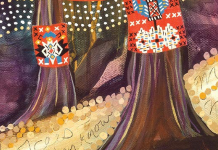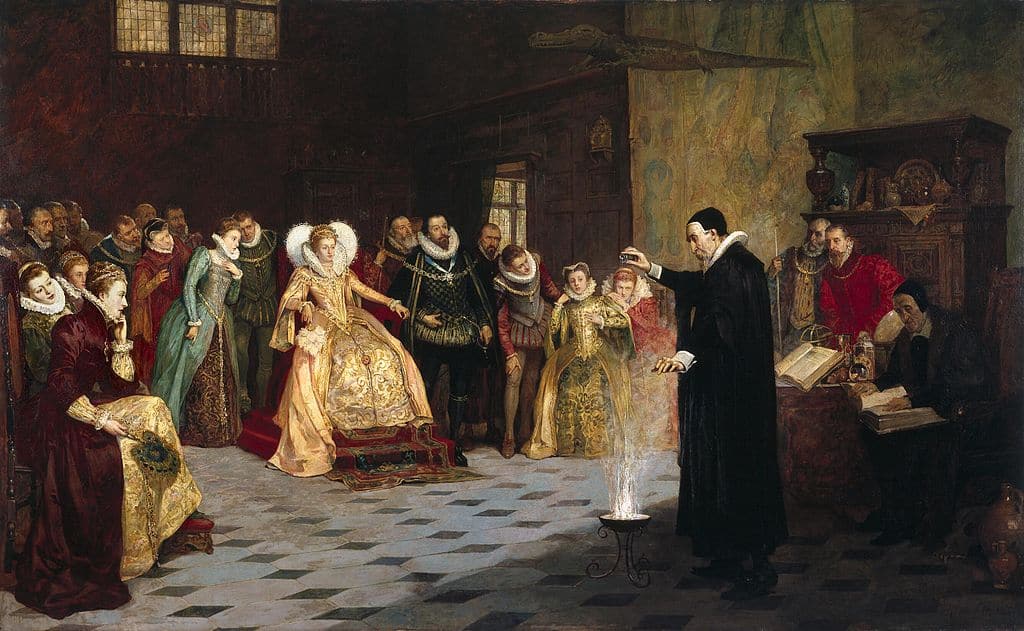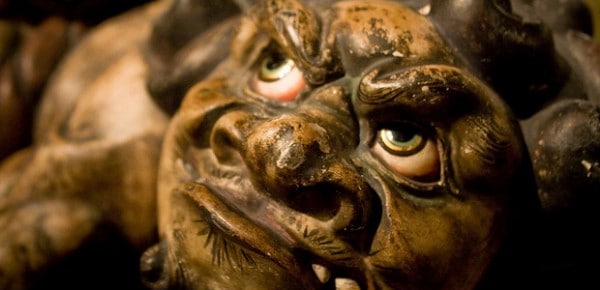 Legend has it that the “Testament of Solomon,” which contains the original text of the Goetia, was left out of the Bible, because it was not considered to be inspired by Jehovah. The “Testament” is accredited to King Solomon, but the real author is unknown.
Legend has it that the “Testament of Solomon,” which contains the original text of the Goetia, was left out of the Bible, because it was not considered to be inspired by Jehovah. The “Testament” is accredited to King Solomon, but the real author is unknown.
Solomon is said to have been the wisest person of his time (848-976 BCE). He was powerful, wealthy, and according to the text, was given a magical ring by the archangel Michael that gave him power over demons. When it was time to build the temple in Jerusalem, Solomon needed help, as it was forbidden in the Torah to use certain kinds of materials. His advisers told him to seek the advice of demons, as they were known to hold forbidden wisdom and would be able to give him the knowledge he desired.
Traditional Goetic evocation
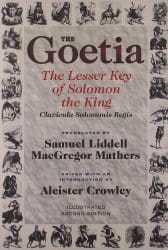 According to the Goetia, in order to get a demon to appear and do as they’re told, a circle is drawn on the ground inside a triangle to contain them. The letters of the archangel Michael are divided into three parts and written in each corner, as it is believed to keep the demon from leaving. The demon is commanded into the circle by the practitioner, and they must appear visibly in the shape of a human, and speak in a clear manner. If they don’t listen, the practitioner commands them in the name of the Abrahamic god, Jesus, and the angels.
According to the Goetia, in order to get a demon to appear and do as they’re told, a circle is drawn on the ground inside a triangle to contain them. The letters of the archangel Michael are divided into three parts and written in each corner, as it is believed to keep the demon from leaving. The demon is commanded into the circle by the practitioner, and they must appear visibly in the shape of a human, and speak in a clear manner. If they don’t listen, the practitioner commands them in the name of the Abrahamic god, Jesus, and the angels.
The next step is to tell the demon they will be cursed and bound in the bottomless pit, where they will suffer in the lake of fire until the day of judgement. If the demon still does not obey, their seal, which was given by the demon, is drawn on parchment and then placed in a black box with items that give off a bad odour. The box is then bound up with wire, and then hit on by the point of a sword which is then held over a fire. The practitioner demands the fire to torment, burn, and consume the demon, and when the box is placed into the fire the demon is said to appear. The demon is then bound to the circle and told to respond appropriately by answering the questions asked. When the task is completed, they are dismissed, but instead of thanking the demon, the practitioner is to give thanks to Jehovah.
According to the “Testament,” Solomon bound the 72 demons of the Goetia into a vessel covered with a symbol known as the Seal of Solomon. In order to make this seal, the practitioner has to abide by strict rules. They cannot have sex for a month and must be in prayer and fasting so that Jehovah will forgive their sins. This seal was placed on the top of the vessel. Christians today view this king as a devoted follower of Jehovah, while some occultists call him a great magician.
What are Goetic demons?
Aleister Crowley had a different view of the Goetic demons. Instead of actual entities, he saw them as aspects of a person’s mind. He believed one could control these aspects through ritual. By commanding a specific demon, one would be able to tap into a part of the subconscious and harness it’s attributes. So, when calling upon Asmodeus, for example, one could bring out the strength to deal with adversity or to enhance their sexual prowess.
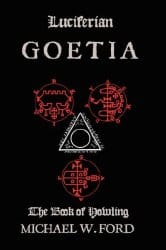 Some groups, such as the Luciferians of the modern day, have similar beliefs and have written their own interpretation of the Goetia, changing the ritual to suit their ideas. Replacing the name Michael with Azazel at the points of the triangle is one such difference. The function of the circle is also changed, and in his book, Luciferian Goetia, Michael Ford describes it this way:
Some groups, such as the Luciferians of the modern day, have similar beliefs and have written their own interpretation of the Goetia, changing the ritual to suit their ideas. Replacing the name Michael with Azazel at the points of the triangle is one such difference. The function of the circle is also changed, and in his book, Luciferian Goetia, Michael Ford describes it this way:
The Circle should be understood as the essence of the Self, that it is the bridge between the waking and dreaming, between the celestial and infernal, the fiery essence of the Azazel.1
Those who call themselves demonolators have a much better approach to the Goetia. They view the demons as divine beings who are full of wisdom. They are their gods and goddesses, and believe them to be benevolent. When communicating with demons they do not demand the demon to do things for them, but if help is needed, they ask politely. In her book, The Complete Book of Demonolatry, S. Connolly has this to say about demons:
Demons have been catalogued since 100-400 AD. This was around the time when the Testament of Solomon appeared, having described the magic ring for commanding the DJINN (i.e. Goetic demons). The Djinn (also jinn) were originally genies from Arabic mythology who granted people wishes. Unfortunately, this particular idea of demons has stuck with people.2
She later says:
In Goetic and Ceremonial Magick, encircling the sigil is often symbolic of having power over a demon. Demonolators do not do this. We do not see ourselves as above the demons.3
It is important to note that demonolators don’t believe in the Christian god or how the Abrahamic religions view the demons or Satan. In fact, they see Satan as the Whole and the demons as a part of the Whole just like everything else including people, animals, and plants. All demons are seen as equal in power to each other.
Demons in Satanism
Like demonolators, theistic Satanists view the Goetia as very disrespectful. They believe that if one wants to communicate with a demon they should be polite and do it with reverence. Abrahamic god names are never used, and the motive for calling a demon is to establish a relationship with them, not to get them to do one’s bidding. For the Satanist, the ritual of the Goetia is not performed. I asked Brother Nero, the author of Satanism: A Beginner’s Guide to the Religious Worship of Satan and Demons Volume 1: Philosophy, what his thoughts are, and this is what he had to say:
Within occult circles, the debate over the origin and age of the Goetia has raged for years, and the debate is likely to continue for many years to come. As a Theistic Satanist, neither of these issues are of great concern to me. What is important to me, is that for the better part of the last century countless numbers of people have focused their Will and intention on the sigils of the Goetia. By virtue of that very act, they have given these sigils a life and power all their own regardless of their age or origin. Even if the sigils were not given to mankind by the demons as some have suggested, it’s likely that the demons have chosen to honour the symbols as their own because of the intent and devotion that has been focused on them.
Who are demons?
These demons are ancient, many of them being the gods and goddesses of the Pagans who have been worshipped throughout the ages in every culture and civilization known to humankind. A triangle drawn on the floor could not hold in a human, not even an animal, if they truly wanted to get out. Does it make any sense that it could contain a primordial entity?
Belial
Astaroth
Beelzebub
Asmodeus
These names alone command respect. A will as strong as theirs cannot be manipulated to perform menial tasks for one’s material gain, success, or power. They are called wicked and disobedient if they don’t listen, but when considering the abusive manner in which they are treated, that is an understatement. Yet the biggest question of all should be, does the name of Jehovah — a desert god from the Middle East — truly have power over these beings? This goes against everything that anyone, like myself, who has a connection with them has experienced.
The Goetia is a detestable ritual, and I would never perform it as it has been passed down. My view is that only the names of the entities, their sigils, and their attributes are authentic. I look up to these demons as my teachers and guides. I believe they should be honoured, and not degraded. I have heard people say to keep a crucifix handy while calling the demons “just in case.” Not only does that sound foolish, but it is dangerous. If one wants assistance, ask with respect, and perhaps you will get it, but not while mocking them in the process. No matter what perspective a ritual is written in, an entity should not be commanded to do something in the name of another entity, enemy or not. If you approach a demon with such detestable objects, expect bad results.
I view the demons as the first teachers of humankind and gods and goddesses in their own right, who cannot be controlled by another, whether god or magician. They are keepers of untold wisdom that we could only hope to know, but if we are fortunate they might decide to share it with us. Thanks to the demons we have philosophy, literature, music, science and so many other things that we take for granted. Occult knowledge comes from them, yet many think they can use it against them — and try.
If you are interested in demons, make a concerted effort to learn about, and hopefully in time, from them. Look everywhere for knowledge and dig deep; don’t just pick up a book of magick and think it holds everything there is to know. Use discernment with anything written by those who see demons as evil, or by those who seem to just want power. The truth can’t be found there. If, after learning as much as you can, you decide you want to know more, you might consider trying to communicate with a demon. See who they truly are and not just what some people wrote down many years ago for their own gain or ignorance.
An alternative approach to Goetic evocation
Choose a demon whose name, sigil, and attributes resonate with you and find out everything you can about the demon such as what element the demon presides over, their colour, the kind of incense and offerings they prefer. Set up a small altar, it doesn’t need to be permanent. Choose the demon’s colours for the altar cloth and candles, and purchase a new bowl to put your offering in. Draw the demon’s sigil on parchment paper with paint or special ink, such as Dragon’s Blood, and place it on the altar.
You might also wish to include an image of the demon. For example, for Belial, you might use a brown altar cloth, green candles, and a black offering bowl. Patchouli is a good incense to use as he seems to favour it, and a good offering would be alcohol, coins, earth, or your own blood.
When you are ready to call the demon, bow before the altar as a manner of respect, light the candle, burn the incense, and then chant the demon’s name, or vibrate a chant that you have written, three times. Recite an invocation specifically for this demon. Tell the demon that you wish to learn from them, and spend time in silence or meditation to see if they have a message for you.
If you don’t receive anything right away, don’t worry, they will often speak at another time through dreams, signs, or impressions. What is important is that you state your intent.
If your offering is tangible, such as an item of food or drink, it can now be placed in the bowl, or if it is something of yourself such as blood or tears, it can be put on the sigil which can then be burned, buried, or kept on your altar or in a safe place.
Close the ritual with a final prayer, thanking the demon for coming. Once again, bow in respect. Instead of banishing or dismissing the demon, they are thanked and invited to stay if they wish. This is what I do in my practice, as it is a sign of appreciation and I enjoy the feel of their presence in the room with me.
In conclusion, the Goetia is written from a Judeo-Christian viewpoint and should be taken as such. The Abrahamic god and his followers must be pleased that people continue to believe that demons are subservient to them and would continue to perpetuate this myth for as long as they can. In regards to the demons being an aspect of the mind, it is understandable why people might want to believe that, or say they do, as it would be quite the ego boost. Yet to deny that these ancient entities exist while using their name for one’s benefit, is not sensible nor wise.
Always seek and keep an open mind. Just because something is in writing doesn’t mean it’s true, and being old doesn’t make it special.
Sources
- Arbel, Ilil .”King Solomon,” Encyclopedia Mythica.
- Macgregor Mathers, Samuel Liddell and Aleister Crowley. The Lesser Key of Solomon.
- Ford, Michael. Luciferian Goetia.
- Connolly, S. The Complete Book of Demonolatry.


